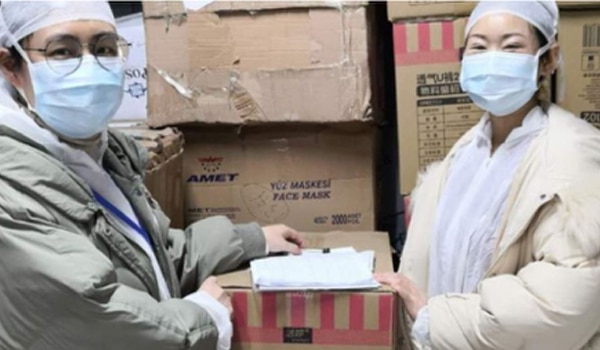
CHINA – Sexual and reproductive health and rights should not be neglected in COVID-19 response
Stories to Action, 10 May 2020
Guo Yeuping, Core Member of China Youth Network (CYN) – the largest youth-led volunteer organization in adolescent sexual and reproductive health and rights (SRHR) in China – highlights the incredible role that young people have played in fighting for SRHR during the Covid-19 pandemic. In response to Covid-19, more than 20,000 medical workers from different provinces and cities of China joined in the emergency aid at the epicenter, Hubei Province.
With plenty of past experiences working on SRHR in crises, we soon noticed female medical worker’s need for menstruation hygiene supplies due to the shortage of sanitary supplies in the affected areas. On 7 February 2020, we donated 2,208 sanitary pads to Zhongnan Hospital, Wuhan University.Then we reassessed the situation. Due to the shortage of protection clothing, medical workers tried their best not to go to the restroom frequently in order to save their personal protection equipment.
Compared to sanitary pads, adult diapers have a better absorbing capacity, can absorb both menses and urine, and are suitable for both male and female medical workers. Thus, we decided to donate adult diapers, to meet more medical workers’ needs and support them….
By 19March 2020, we had donated 92,044 adult diapers, 41,610 nursing pads, 5,680 sanitary pads, 3,280 medical face shields, 1,200 bottles of hand disinfectant solution, 925 disposable beddings, 500 bottles of air disinfectant and some medical machines to hospitals in Hubei Province.
+++
BMJ GLOBAL HEALTH

Gendered implications of the COVID-19 pandemic for policies and programmes in humanitarian settings
Although preliminary analysis indicates that Covid-19 poses the highest risk to men, the elderly and those with co-morbidities, available research on the gendered implications of past public health emergencies – such as that from the 2014–2016 West Africa Ebola outbreak – demonstrates that women and girls are disproportionately affected, particularly those who live in ongoing humanitarian crises…. These findings informed recommendations that include: support women’s and girls’ leadership to ensure that Covid-19 prevention and control measures do not exacerbate harmful norms; bolster water, sanitation and hygiene services along with psychosocial support, essential health services, safe shelter and the provision of food, nutrition and hygiene commodities; prepare to respond to possible surges in gender-based violence and sexual exploitation and abuse; and ensure that vulnerable populations are included in national surveillance, preparedness and response plans and activities.
BMJ Global Health by Sarah Fuhrman, Anushka Kalyanpur, Susannah Friedman, Nguyen Toan Tran,
2020;5(5) (Open access)
+++
WHO BULLETIN

The need for a coordinated international pandemic response
WHO’s consistent recommendation has been that countries avoid trade and travel restrictions where possible. This recommendation is based on evidence suggesting that such restrictions may slow the spread of disease, but do not prevent it, while impacting the global economy and people’s well-being. Travel and trade restrictions also disrupt the supply chains vital to pandemic response efforts. They have had a significant impact on the delivery of equipment needed for personal protection of health workers, ventilators and other intensive care unit equipment,” says Dr David Heymann, professor of infectious disease epidemiology at the London School of Hygiene & Tropical Medicine. “They have also hampered the transfer of humanitarian workers including experts needed to give technical support for outbreak control including testing and contact tracing.”
WHO Bulletin, by Lynn Eaton, Gary Humphreys, June 2020
+++
GLOBAL HEALTH ACTION

An invisible workforce: the neglected role of cleaners in patient safety on maternity units
Hospital cleaning has been shown to impact on rates of healthcare-associated infections (HCAIs) and good environmental hygiene is critical to quality care, yet those tasked with the role of ensuring a safe and clean environment often go unrecognised as members of the healthcare workforce. Sepsis is a leading cause of maternal and newborn death, a significant proportion of these cases are estimated to be due to HCAIs. Deliveries in health institutions have now reached 75% globally, and in low and middle-income countries, the corresponding increased pressure on facilitieshas affected both quality of care provided and quality of the birth environment in terms of infection prevention and control and HCAIs. The paper provides evidence from the literature and from needs assessments in Bangladesh, India, The Gambia and Zanzibar. While not the primary focus of the assessments, common themes emerged consistently pointing to institutional neglect of cleaning and cleaners. The paper argues that low status within facilities, wider societal marginalisation, lack of training, and poor pay and working conditions contribute to the lack of prioritisation placed on health facility environmental hygiene.
+++
JAPAN

Contact tracing and peer pressure: how Japan has controlled coronavirus
by Dr Tomoya Saito, Director, Department of Health Crisis Management, National Institute of Public Health, Japan, 6 June 2020
VISUAL: Digital contact tracing, Harvard Business Review/Getty Images
+++
MASKS

We can’t be 100% sure face masks work – but that shouldn’t stop us wearing them
by Trish Greenhalgh, Professor of Primary Care Health Sciences, Oxford University, UK, 5 June 2020
VISUALS: LA Times ; UK Reuters.com
+++
DIGITAL TECHNOLOGIES

Strengthening health systems using digital technologies in the midst of the Covid-19 pandemic to ensure universal health coverage
Commonwealth Civil Society Policy Forum Report, 6 May 2020



